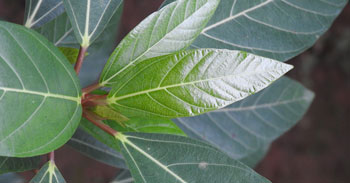KJC Medicinal Garden
Atti
Ficus racemosa
Order: Rosales
Family: Moraceae – mulberries
Genus: Ficus L.
Species: Ficus racemosa L. – clustertree
Common Names: Figs
Native to Indian Subcontinent, southern China, Southeast Asia, Papua New Guinea to Northern Australia Northern Territory, North of Western Australia and Queensland. It is also introduced to other tropical regions in South America.
Other plants of the same genus with medicinal properties
-
Ficus Benghalensis(Indian banyan or the wish fulfilling tree)
Ficus religiosa (Bodhi tree or sacred tree)
Ficus racemosa (goolar fig)
Ficus carica (common fig)
- Leaves: The leaves are dark green, 6-10 cm long, glabrous; receptacles small subglobose or piriform, in large clusters from old nodes of main trunk
- Fruits: The fruits receptacles are 3-6 cm in diameter, pyriform, in large clusters, arising from main trunk or large branches.
- Seeds: The seeds are tiny, innumerable and grain-like.
- Bark: Bark is reddish grey or grayish green, soft surface, uneven and often cracked.
- Roots: The roots of F.racemosa are long, brownish in colour.
- It’s having characteristic odour and slightly bitter in taste .
Uses in Tradition systems of medicine
- Leaves:-A mixture of leaves powdered with honey is used in bilious infections. A decoction of leaves is used as a douche in dysmenorrhea, as a wash for wounds and ulcers. Leaf juice is massaged on hair to prevent splitting. Leaf latex is used for boils and blisters and measles.
- Fruits:-The fruit is an astringent, stomachic, carminative given in menorrhea and hemoptysis . Fruits are used as a remedy for visceral obstruction, diarrhea and constipation . A bath made of fruit and bark is regarded as a cure for leprosy. The fruit is regarded as a good remedy for diabetes .
- Bark:-The bark is astringent. An infusion of bark is employed as mouth wash in spongy gum condition, dysentery, menorrhea, hemoptysis, and diabetes. It is also used as a wash for wounds, highly efficacious in threatened abortions and also recommended in uropathy. A decoction of bark is given in asthma and piles . The sap extracted from the trunk has been described as valuable medicine in diabetes. Paste of stem bark is used in burns, swelling, leucorrhea dysentery and diarrhea .
- Latex: The latex is aphrodisiac and is administered in boils, diarrhea, dysentery, and hemorrhoids . It is also used to cure stomachache , cholera and mumps . It has been reported in the indigenous system of medicine in Sri Lanka in the treatment of skeletal fracture to control severe diarrhea, particularly in children. Latex is used as adhesive.
- Sap of the root:-Sap of the root is given for gonorrhea, diabetes and as a topical application in mumps and other inflammatory glandular enlargements. Root sap is claimed to cure heat stroke, chronic wounds and malaria in cattle .
- Vitamin B2 (Riboflavin) 0.4 mg (30.77%)
- Iron, Fe 1.3 mg (16.25%)
- Copper, Cu 0.1 mg (11.11%)
- Potassium, K 508 mg (10.81%)
- Magnesium, Mg 35 mg (8.33%)
- Calcium, Ca 72 mg (7.20%)
- Phosphorus, P 47 mg (6.71%)
- Vitamin B1 (Thiamin) 0.05 mg (4.17%)
- Zinc, Zn 0.3 mg (2.73%)
- Protein 1.3 g (2.60%
Suggested Medicinal Properties
- Hyp Antioxidant and radioprotective activity
- Oglycemic/antihyperglycemic activity
- Epatoprotective activity
- Chemopreventive activity
- Anti-inflammatory activity
- Analgesic activity
- Antibacterial activity
- Antifungal activity
- Gastroprotective activity
- Antidiarrheal activity
- Antifilarial activity
- Larvicidal/wormicidal activity
- Antipyretic activity
Active Phytochemicals
1. Polysterols:- Bergapten, bergaptol, lanosterol, β-sitosterol, stigmasterol, β-sitosterol-d-glucoside (Phytosterolin) ,Taraxasterol, psoralen and bergapten (5-methoxypsoralen).
2. Flavonoids:- Leucocyanidin-3-O-β-glucopyranosid, leucopelargonidin-3-O-β-d-glucopyranoside, leucopelargonidin-3-O-α-l-rhamnopyranoside, lupeol, cetyl behenate, acetate and α-amyrin acetate, Kaempferol, quercetin, and myricetin, Kaempferol, quercetin, myricetin, Quercetin, quercetin 3-O-l-rhamnopyranosyl (1-6)-β-d-glucopyranoside.
3. Polyphenols:- Tannin, wax, saponin, leucoanthocyanidin, leucoanthocyanin, Eugenol, 2-phenylethyl alcohol, and benzyl alcohol, hexenol, n-hexanol, phytol, benzyl alcohol.
4. Miscellaneous compounds:- Undecane, tridecane, tetradecane, (e)-β-ocimene β-bourbonene, β-caryophyllene, α-trans bergamotene, α-thujene, α-pinene, β-pinene, α-terpinene, limonene, dendrolasine, dendrolasine α-ylangene, α-copaene, aromadendrene, α-humulene, alloaromadendrene, germacrene, bicycle-germacrene, γ-cadinene and δ-cadinene.
5. Phenolic acids:- Betulinic acid, lupeol, Gallic acid, Malic acid
6. Sterols:- Stigmasterol, bergapten, scopoletin, β-sitosterol-3-O-β-d-glucopyranoside.
7. Volatile compounds:- Carvacrol, α-caryophyllene, caryophyllene oxide, linalool, 3-tetradecanone, geranylacetone, 3,7,11-trimethyl-3-hydroxy-6;10-dodecadiene-1-yl acetate, hexahydrofarnesyl acetone, α-caryophyllene, 2-methyl-3-hexyne and scytalone.
8. Anthocyanins:- Trihydroxy-stilbene-3, 5-O-β-d-diglucopyranoside, euphol-3-ocinnamate, lupeol, taraxar-14-ene, Cetyl behenate, lupeol, α-amyrin acetate.
9. Terpenes:- Pentacyclic triterpenes 8,26-cyclo-urs-21-en3β, 20β-diol and 3β-acetoxy-8, 26-cyclo-ursan-20β-ol and also 3-friedelanone.
References
Traditional uses, medicinal properties, and phytopharmacology of Ficus racemosa: A review Faiyaz Ahmed &Asna Urooj Pages 672-681 | Received 22 Feb 2009, Accepted 14 Apr 2009, Published online: 06 May 2010
BOTANICAL STUDY OF FOUR FICUS SPECIES OF FAMILY MORACEAE: A REVIEW
